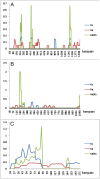Adaptive evolution of energy metabolism genes and the origin of flight in bats
- PMID: 20421465
- PMCID: PMC2889356
- DOI: 10.1073/pnas.0912613107
Adaptive evolution of energy metabolism genes and the origin of flight in bats
Abstract
Bat flight poses intriguing questions about how flight independently developed in mammals. Flight is among the most energy-consuming activities. Thus, we deduced that changes in energy metabolism must be a primary factor in the origin of flight in bats. The respiratory chain of the mitochondrial produces 95% of the adenosine triphosphate (ATP) needed for locomotion. Because the respiratory chain has a dual genetic foundation, with genes encoded by both the mitochondrial and nuclear genomes, we examined both genomes to gain insights into the evolution of flight within mammals. Evidence for positive selection was detected in 23.08% of the mitochondrial-encoded and 4.90% of nuclear-encoded oxidative phosphorylation (OXPHOS) genes, but in only 2.25% of the nuclear-encoded nonrespiratory genes that function in mitochondria or 1.005% of other nuclear genes in bats. To address the caveat that the two available bat genomes are of only draft quality, we resequenced 77 OXPHOS genes from four species of bats. The analysis of the resequenced gene data are in agreement with our conclusion that a significantly higher proportion of genes involved in energy metabolism, compared with background genes, show evidence of adaptive evolution specific on the common ancestral bat lineage. Both mitochondrial and nuclear-encoded OXPHOS genes display evidence of adaptive evolution along the common ancestral branch of bats, supporting our hypothesis that genes involved in energy metabolism were targets of natural selection and allowed adaptation to the huge change in energy demand that were required during the origin of flight.
Conflict of interest statement
The authors declare no conflict of interest.
Figures



References
-
- Nowak RM. Walker's Mammals of the World. 6th Ed. Baltimore: Johns Hopkins University Press; 1999.
-
- Thomas SP, Suthers RA. The physiology and energetics of bat flight. J Exp Biol. 1972;57:317–335.
-
- Norberg UM. Wing design, flight performance, and habitat use in bats. In: Wainwright PC, Reilly SM, editors. Ecological Morphology: Integrative Organismal Biology. Chicago: University of Chicago Press; 1994. pp. 205–239.
-
- Darwin C. On the Origin of Species by Means of Natural Selection. London: John Murray; 1859.
-
- Bishop KL. The evolution of flight in bats: Narrowing the field of plausible hypotheses. Q Rev Biol. 2008;83:153–169. - PubMed
Publication types
MeSH terms
Associated data
- Actions
- Actions
- Actions
- Actions
- Actions
- Actions
- Actions
- Actions
- Actions
- Actions
- Actions
- Actions
- Actions
- Actions
- Actions
- Actions
- Actions
- Actions
- Actions
- Actions
- Actions
- Actions
- Actions
- Actions
- Actions
- Actions
- Actions
- Actions
- Actions
- Actions
- Actions
- Actions
- Actions
- Actions
- Actions
- Actions
- Actions
- Actions
- Actions
- Actions
- Actions
- Actions
- Actions
- Actions
- Actions
- Actions
- Actions
- Actions
- Actions
- Actions
- Actions
- Actions
- Actions
- Actions
- Actions
- Actions
- Actions
- Actions
- Actions
- Actions
- Actions
- Actions
- Actions
- Actions
- Actions
- Actions
- Actions
- Actions
- Actions
- Actions
- Actions
- Actions
- Actions
- Actions
- Actions
- Actions
- Actions
- Actions
- Actions
- Actions
- Actions
- Actions
- Actions
- Actions
- Actions
- Actions
- Actions
- Actions
- Actions
- Actions
- Actions
- Actions
- Actions
- Actions
- Actions
- Actions
- Actions
- Actions
- Actions
- Actions
- Actions
- Actions
- Actions
- Actions
- Actions
- Actions
- Actions
- Actions
- Actions
- Actions
- Actions
- Actions
- Actions
- Actions
- Actions
- Actions
- Actions
- Actions
- Actions
- Actions
- Actions
- Actions
- Actions
- Actions
- Actions
- Actions
- Actions
- Actions
- Actions
- Actions
- Actions
- Actions
- Actions
- Actions
- Actions
- Actions
- Actions
- Actions
- Actions
- Actions
- Actions
- Actions
- Actions
- Actions
- Actions
- Actions
- Actions
- Actions
- Actions
- Actions
- Actions
- Actions
- Actions
- Actions
- Actions
- Actions
- Actions
- Actions
- Actions
- Actions
- Actions
- Actions
- Actions
- Actions
- Actions
- Actions
- Actions
- Actions
- Actions
- Actions
- Actions
- Actions
- Actions
- Actions
- Actions
- Actions
- Actions
- Actions
- Actions
- Actions
- Actions
- Actions
- Actions
- Actions
- Actions
- Actions
- Actions
- Actions
- Actions
- Actions
- Actions
- Actions
- Actions
- Actions
- Actions
- Actions
- Actions
- Actions
- Actions
- Actions
- Actions
- Actions
- Actions
- Actions
- Actions
- Actions
- Actions
- Actions
- Actions
- Actions
- Actions
- Actions
- Actions
- Actions
- Actions
- Actions
- Actions
- Actions
- Actions
- Actions
- Actions
- Actions
- Actions
- Actions
- Actions
- Actions
- Actions
- Actions
- Actions
- Actions
- Actions
- Actions
- Actions
- Actions
- Actions
- Actions
- Actions
LinkOut - more resources
Full Text Sources

